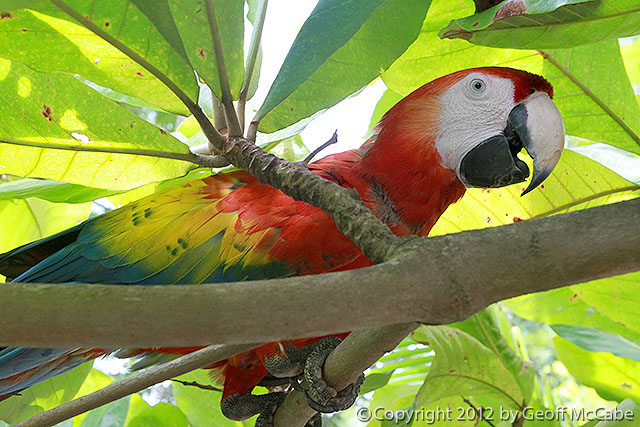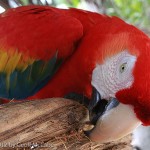- Home
- Accommodation
- Activities
- Area Info
- Maps
- Photo Galleries
- Real Estate
- Travel
Scarlet Macaw
Spanish Name: Guacamayo Rojo, Lapa
Habitat: Lives in elevated trees of deciduous or tropical evergreen jungles.
Lifespan: 40-50 years in the wild and up to 75 years in captivity.
Height/Weight: An adult Scarlet Macaw is 84 cm long and weighs 900 g.
 This vividly colored, medium-sized macaw is the only one of its kind found on the Pacific side of Costa Rica. Macaws are the largest parrots in America, and the Scarlet Macaw is sharp and distinguishable both in color and shape. It is easy to tell this bird apart from any other aerial in Costa Rica. It has long and spiky tail feathers, and the wings are too short for its large body. Scarlet Macaws have a large and strong bill for breaking open tough seeds and nuts. Their back is covered with a layer of bright crimson feathers. The lower back and wings are a dramatic electric, with big yellow strips running across them. Their facial skin is pinkish in tone, and the bill a combination of off-white and deep black.
This vividly colored, medium-sized macaw is the only one of its kind found on the Pacific side of Costa Rica. Macaws are the largest parrots in America, and the Scarlet Macaw is sharp and distinguishable both in color and shape. It is easy to tell this bird apart from any other aerial in Costa Rica. It has long and spiky tail feathers, and the wings are too short for its large body. Scarlet Macaws have a large and strong bill for breaking open tough seeds and nuts. Their back is covered with a layer of bright crimson feathers. The lower back and wings are a dramatic electric, with big yellow strips running across them. Their facial skin is pinkish in tone, and the bill a combination of off-white and deep black.
Often considered as Costa Rica’s most gorgeous looking bird, the scarlet macaw would often be spotted noisily flying over forest canopies such as in Corcovado National Park. Sadly, this magnificent creature was often hunted and captured until its numbers dwindled to extinction. They have also been extensively poached to feed their demand in the pet market. They have faced habitat destruction and encroachment by humans. However, reintroduction programs at the Curu Park and Barcelo Resort have given them a new lease of life. There have been consistent efforts by various activists and programs to increase their numbers in Costa Rica and to make them a part of the mainstream aerial life again. Thanks to the efforts at Curu and other reserves, their numbers are slowly increasingly and they may be able to make their way into the mainstream Costa Rica birds list soon.
The macaws flying range covers an extensive area. Their loud, screechy sounds can often be heard while flying over forest canopies, but they are unusually silent when they eat. Scarlet Macaws can be spotted in duos, trios, or small intimate groups, but these groups can also join a flock of 25 or sometimes 50 birds to form a large roost.
 The scarlet macaw largely forages in the tree canopies, feasting on large seeds, fruits and nuts in the trees. Their favorite food in Costa Rica, is the ripe seed of Terminalia catappa. Searching for the big sized almond-shaped seeds hidden under the tough nut, the macaw removes huge chunks of the hard fruit using the sharp edge of its lower claws. Scarlet Macaws are quick foragers and a flock can sweep the ground with three hundred of these fruits in less than an hour.
The scarlet macaw largely forages in the tree canopies, feasting on large seeds, fruits and nuts in the trees. Their favorite food in Costa Rica, is the ripe seed of Terminalia catappa. Searching for the big sized almond-shaped seeds hidden under the tough nut, the macaw removes huge chunks of the hard fruit using the sharp edge of its lower claws. Scarlet Macaws are quick foragers and a flock can sweep the ground with three hundred of these fruits in less than an hour.
The Scarlet Macaw lives in large holes of hollow trees abandoned by other animals. They do not take the trouble to dig these holes themselves, but rely on finding other’s elevated cavity homes. A macaw duo will lay 1-2 eggs per season in a single nest and raise them as a couple. Though by nature macaws are monogamous, they are also known to change mates after some seasons.
For More Information
http://www.rainforest-alliance.org/kids/species-profiles/macaw
http://www.costaricajourneys.com/scarlet-macaws/
http://costarica.com/wildlife/scarlet-macaws/
Great Stuff

Clandestina Restaurant
My new favorite restaurant, Clandestina is not to be missed by food lovers staying anywhere near to Montezuma. Established in March 2015, Clandestina is the new kid on the block. The Oregon/Tico collaboration is a winner among locals and travelers alike, with artisan craft beers, made onsite by Butterfly Brewing Co. and delicious, exciting […]











